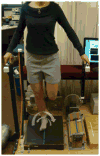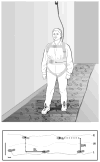Which lower limb frontal plane sensory and motor functions predict gait speed and efficiency on uneven surfaces in older persons with diabetic neuropathy?
- PMID: 22796383
- PMCID: PMC3477498
- DOI: 10.1016/j.pmrj.2012.05.002
Which lower limb frontal plane sensory and motor functions predict gait speed and efficiency on uneven surfaces in older persons with diabetic neuropathy?
Abstract
Objective: To identify which frontal plane lower limb sensorimotor functions predict gait speed and efficiency (step-width-to-step-length ratio) on an uneven surface.
Design: Cross-sectional observational study.
Setting: A biomechanics research laboratory.
Participants: Thirty-three subjects (14 women [42.4%]; 21 with diabetic distal symmetric peripheral neuropathy [63.6%]), with a spectrum of lower limb sensorimotor functions that ranged from normal to marked diabetic neuropathy.
Methods: Independent variables included ankle inversion-eversion proprioceptive thresholds, and normalized measures of maximum voluntary strength and maximum rate of torque development (RTD) of hip abduction-adduction and ankle inversion-eversion. Kinematic data were obtained by using an optoelectronic system as subjects walked over an uneven 10-m surface.
Main outcome measures: Dependent variables included gait speed and efficiency (determined by step-width-to-step-length ratio) on an uneven surface.
Results: Hip adduction RTD and ankle inversion RTD predicted 54% of gait speed, with the former predicting the majority (44%). Ankle inversion RTD was the only significant predictor of gait efficiency, which accounted for 46% of its variability. Age did not predict gait speed or efficiency.
Conclusions: The rapid generation of strength in the frontal plane at the hip and ankle is responsible for the successful negotiation of irregular surfaces in older persons. Age demonstrated no independent influence. Training regimens in older persons should include maneuvers that rapidly develop strength in hip adductors and ankle invertors if navigation of uneven surfaces is a functional goal.
Copyright © 2012 American Academy of Physical Medicine and Rehabilitation. Published by Elsevier Inc. All rights reserved.
Figures




References
-
- Wild S, Roglic G, Green A, Sicree R, King H. Global prevalence of diabetes: estimates for the year 2000 and projections for 2030. Diabetes Care. 2004;27:1047–53. - PubMed
-
- Gutierrez EM, Helber MD, Dealva D, Ashton-Miller JA, Richardson JK. Mild diabetic neuropathy affects ankle motor function. Clin Biomech (Bristol, Avon) 2001;16:522–8. - PubMed
-
- Allet L, Armand S, de Bie RA, et al. Gait alterations of diabetic patients while walking on different surfaces. Gait Posture. 2009;29:488–93. - PubMed
-
- Allet L, Armand S, Golay A, Monnin D, de Bie RA, de Bruin ED. Gait characteristics of diabetic patients: a systematic review. Diabetes Metab Res Rev. 2008;24:173–91. - PubMed
-
- DeMott TK, Richardson JK, Thies SB, Ashton-Miller JA. Falls and gait characteristics among older persons with peripheral neuropathy. Am J Phys Med Rehabil. 2007;86:125–32. - PubMed

